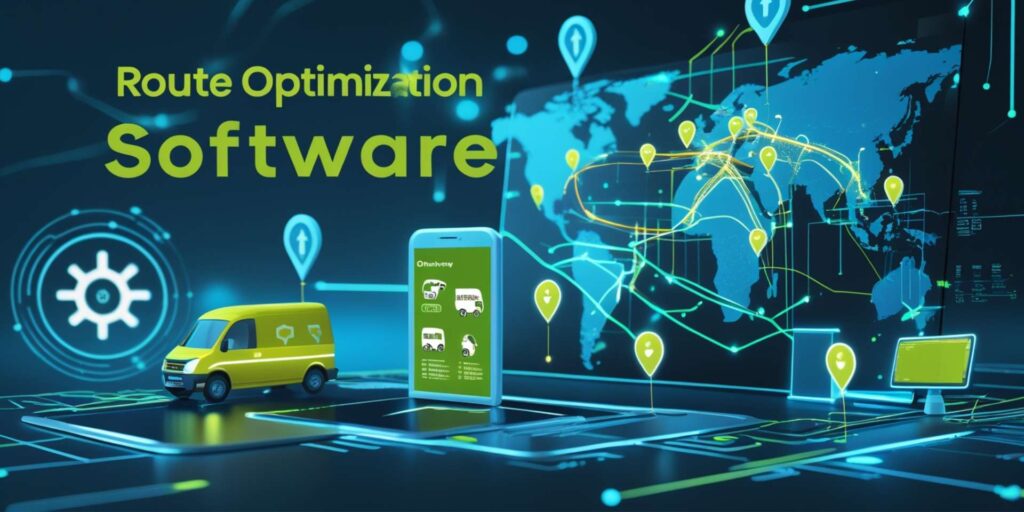In this modern world of delivery and logistics where everything is competitive, companies are always trying to find ways to cut down on costs, operations, and customer satisfaction. The emergence of e-commerce, the demand to deliver goods within the same day and increasing complexity of the supply chain has ensured that efficient route planning is never more essential than it is now. Regardless of whether you run a small delivery company with only a few drivers or have a huge fleet of cars with hundreds of workers, the dilemma always lies in how you can make the drivers route as efficient as possible when multiple stops are necessary.
Here Route Optimization Software comes to the rescue. No more are the days of taking a paper map and hand plotting your route, or using a simple GPS which takes each stop as a standalone. State of the art route optimization software is based on advanced algorithms, real time traffic information and artificial intelligence to design the most efficient multi-stop route you can possibly get. Such tools are not only time and fuel-saving, but they also transform the way businesses go about logistics, where the time-consuming, error-prone process becomes an automated, smart system that adjusts to the changing circumstances daily.
What is Route Optimization Software?
Route Optimization Software is a complex digital tool that automatically computes the most efficient routes that vehicles should follow when making multiple stops. As opposed to the more conventional GPS navigation systems that only tell you to go point A to point B, route optimizing tools take into account so many variables at once to generate the best possible multi-stop routes. These intelligent systems take into consideration traffic patterns, time windows delivery, vehicle capacity limits, driver schedules and road constraints to create routes with the least travel time, least amount of fuel used and the most efficient operations that reduce costs.
The Route Optimization Software technology is usually based on the use of advanced algorithms, such as the infamous Traveling Salesman Problem solutions, machine learning models, and the integration of real-time data. The systems are able to calculate hundreds of stops on a number of vehicles within a few seconds, which would take human planners hours or days to plan manually. The dynamic routing features are also available in modern solutions, which enable making real-time changes in case of any unpredictable circumstances, including traffic jams, vehicle breakdowns, or delivery requests, made at the last minute. Such flexibility makes it possible to keep the quality of the services despite the minimal disturbances to the scheduled activities of businesses.
Benefits of Using Multi-Stop Route Optimization Software
- Cost Reduction: By eschewing unnecessary mileage and sequencing deliveries correctly, companies see in the 10-30% range of reduction in their operation expenses.
- Customer Satisfaction: The software offers a better communication line with customers for delivery windows and minimizes no-show appointments or delays.
- Productivity Enhancements: The number of deliveries a driver can perform in a given time frame increases, which allows more customers to be served with the same amount of resources.
- Environmental-friendly: Fewer miles driven equals optimized routes and less carbon emission. From an environmental point of view, this mainly lowers your carbon footprint, which will also go a long way in appealing to environmentally conscious customers and partners.
- Driver Satisfaction: Short, sensible routes reduce stress and fatigue for drivers. Happy,and more productive drivers are less likely to quit and provide better customer service, along with creating a positive feedback loop for your business.
- Flexible to Adapt in Real Time: Modern-day systems dynamically re-route and adjust for traffic conditions, weather conditions, or an urgent delivery request in such a way that the routes remain the most optimal.
Key Features to Look for in Route Optimization Software
- Multi-Vehicle Planning: The capability to optimize routes for more than one vehicle at a time, taking into account various capacities, driver schedules, or certain operational constraints.
- Real Time Traffic Integration: Advanced systems consider live traffic data to dodge congestion and reroute when faster routes come up to on-time service track during rush.
- Delivery Time Windows: Respect specific delivery times where customers can choose delivery windows, and the system will schedule optimized routes to meet those constraints.
- Mobile Driver Apps: Android and iOS apps with turn-by-turn navigation and delivery status updates that allow users to capture signatures for frictionless field operations.
- Analytics and Reporting: Full-fledged reporting suite that offers enlightened analytics on route level in terms of driver performance, fuel consumption, and customer satisfaction metrics, giving results to base decisions on and driving continuous improvements.
- Integration Capabilities: Flawless integration into one’s current line of business, such as a CRM platform, ensures route optimization becomes part of your unified business workflow rather than an isolated tool.
List of 10 Best Route Optimization Software for Multi-Stop Routes in 2025
1. Routific
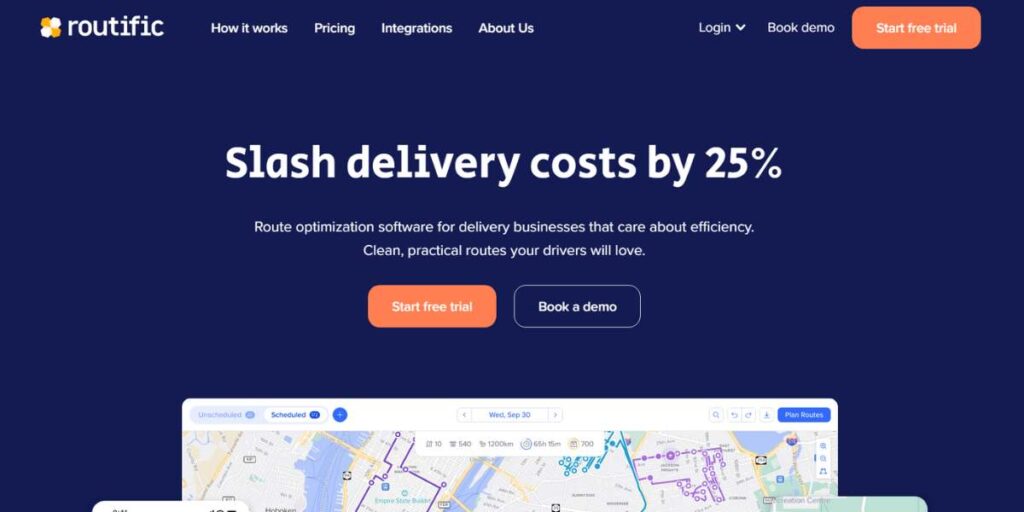
Routific is a Route Optimization Software that is simple to use and is the best choice in local delivery organizations. The platform is geared towards simplicity, but does not compromise on effective optimization features, which makes it stand out as a good fit to small to medium-sized firms that have been using manual route planning in their operations. One of the strong points of Routific is that it has an intuitive interface as it only takes minutes to plan optimized routes instead of hours.
The program is also quite good at managing different delivery constraints such as time windows, capacity of vehicles and preferences of drivers. The company has high customer support and onboarding, which means that businesses can use the route optimization technology fast and to their advantage.
Key Features:
- One-click route optimization for up to 120 stops
- Real-time driver tracking and notifications
- Proof of delivery with photo and signature capture
- Customer notification system with SMS and email alerts
- Driver mobile app with offline navigation capabilities
- Integration with popular e-commerce platforms
Pros:
- Extremely user-friendly interface perfect for beginners
- Excellent customer support and training resources
- Competitive pricing for small to medium businesses
Cons:
- Limited advanced features compared to enterprise solutions
- Fewer integration options than larger platforms
Best For: Small to medium local delivery businesses seeking simplicity and ease of use
Pricing: Plans start at $39/month for up to 5 vehicles, with scalable options based on fleet size
2. OptimoRoute
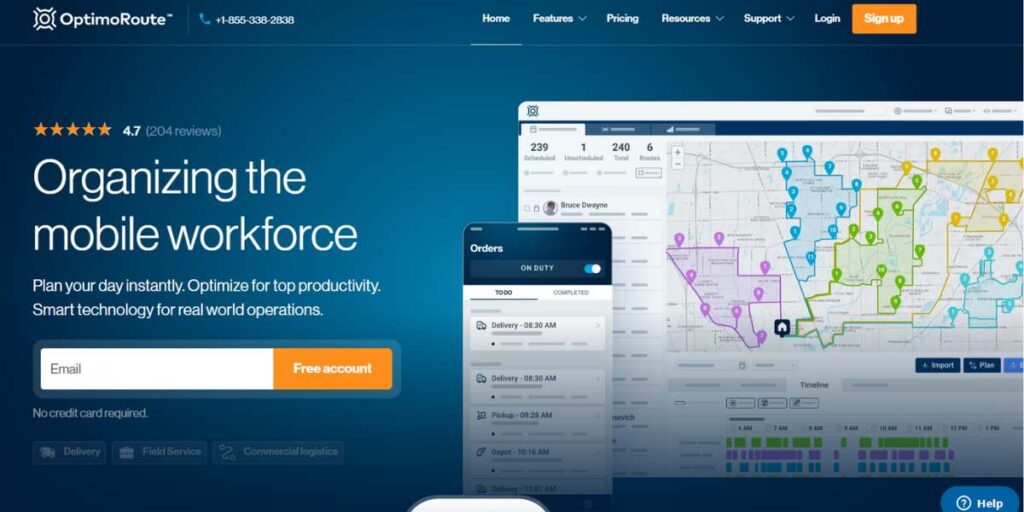
OptimoRoute provides a full-service Route Optimization Software that has superior planning features and rich customization. It is a platform that serves businesses that need advanced route planning that has many constraints and variables. The algorithm in OptimoRoute takes into account many parameters at once, and these factors are the skills of the drivers, the type of vehicles, service time, as well as complex delivery requirements.
The strength of the software is in its capacity to deal with complex logistics situations and at the same time, have a user-friendly interface. OptimoRoute has such features as balancing routes among drivers and the reporting system, which are deep enough to be used by a complex delivery operation and still approachable to everyday users.
Key Features:
- Multi-day and recurring route planning
- Advanced constraint handling (skills, vehicle types, time windows)
- Route balancing and workload distribution
- Real-time GPS tracking and notifications
- Comprehensive analytics dashboard
- API access for custom integrations
Pros:
- Highly customizable to specific business needs
- Strong algorithm handles complex routing scenarios
- Excellent reporting and analytics capabilities
Cons:
- Steeper learning curve due to advanced features
- Higher price point than simpler alternatives
Best For: Medium to large businesses with complex routing requirements and multiple constraints
Pricing: Custom pricing starting around $44/month per vehicle with enterprise options available
3. Route4Me
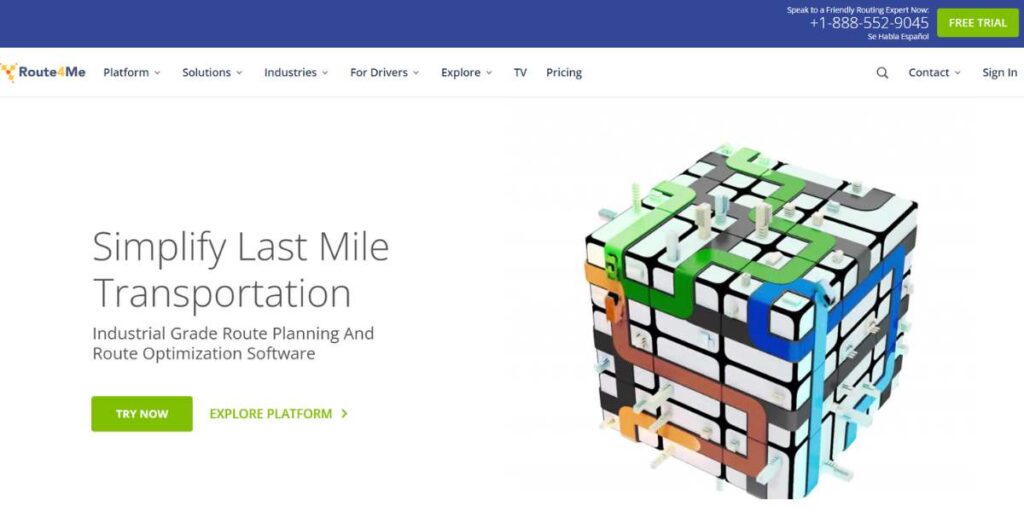
Route4Me presents itself as one of the most robust solutions in the market and features that can be used by businesses of all scales. The modularity of the platform enables such users to begin with simple route optimization and then include more advanced features as their requirements increase. The most impressive attribute of Route4Me is its enormous scalability that allows routes that involve thousands of stops and still being optimized.
The software also has special features such as compliance routing tracking, geocoding among the most enhanced features, and wide-ranging third-party integrations. Being both efficient and scalable, Route4Me is the solution that can be used by businesses that intend to grow in the long perspective.
Key Features:
- Unlimited stops per route optimization
- Advanced geocoding and address validation
- Route recording and playback for compliance
- Comprehensive marketplace of add-on features
- White-label solutions for service providers
- Extensive API and webhook capabilities
Pros:
- Highly scalable from small businesses to enterprise
- Extensive feature set and customization options
- Strong API for custom development needs
Cons:
- Can be overwhelming for users seeking simple solutions
- Pricing can become expensive with multiple add-ons
Best For: Businesses requiring maximum scalability and extensive customization options
Pricing: Plans start at $199/month for 10 users, with additional modules priced separately
4. Onfleet
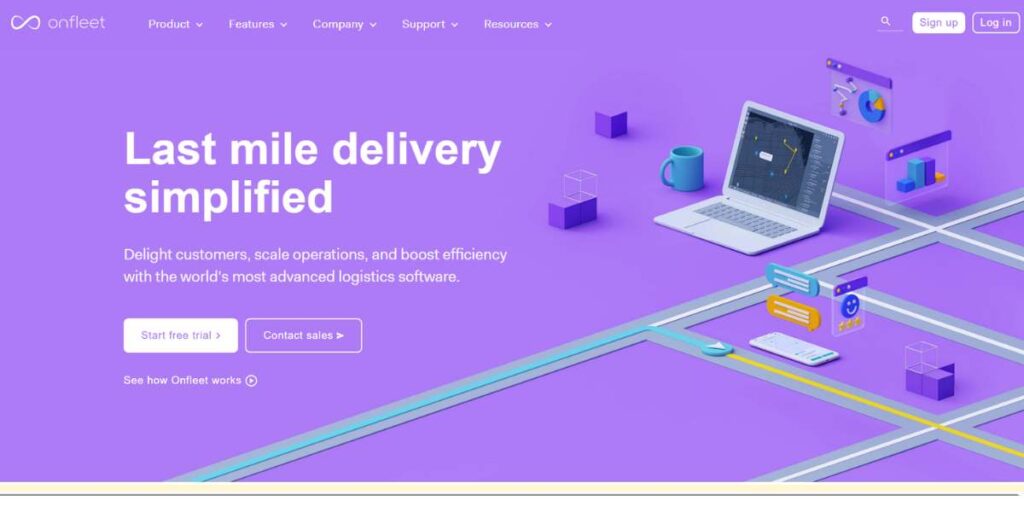
Onfleet is a company that focuses on last-mile delivery optimization with a set of specifically tailored to the current problems of delivery. A smart route planning platform with advanced delivery management features make the platform an end-to-end solution to delivery operations. Onfleet algorithm is very good at dynamic routing, which means that it will automatically update the routes when new orders are placed or when the situation changes during the day.
The customer focus of the software consists of such features as real-time tracking pages, automatic notifications, and feedback gatherings of the delivery. Onfleet is a tool which attracts companies that are concerned not only with the efficiency of their work but also with customer satisfaction, as it prioritizes the delivery experience as a whole over the route optimization.
Key Features:
- Dynamic route optimization with real-time updates
- Customer-facing tracking and notification system
- Proof of delivery with multiple verification options
- Advanced analytics and performance reporting
- Dispatcher dashboard with live fleet monitoring
- Robust API for custom integrations and workflows
Pros:
- Excellent customer experience features
- Strong real-time optimization capabilities
- Professional customer support and onboarding
Cons:
- Higher pricing compared to basic route optimizers
- May have more features than needed for simple delivery operations
Best For: Businesses focused on premium last-mile delivery experiences and customer satisfaction
Pricing: Plans start at $550/month for up to 2,500 tasks, with enterprise pricing available
5. Circuit for Teams
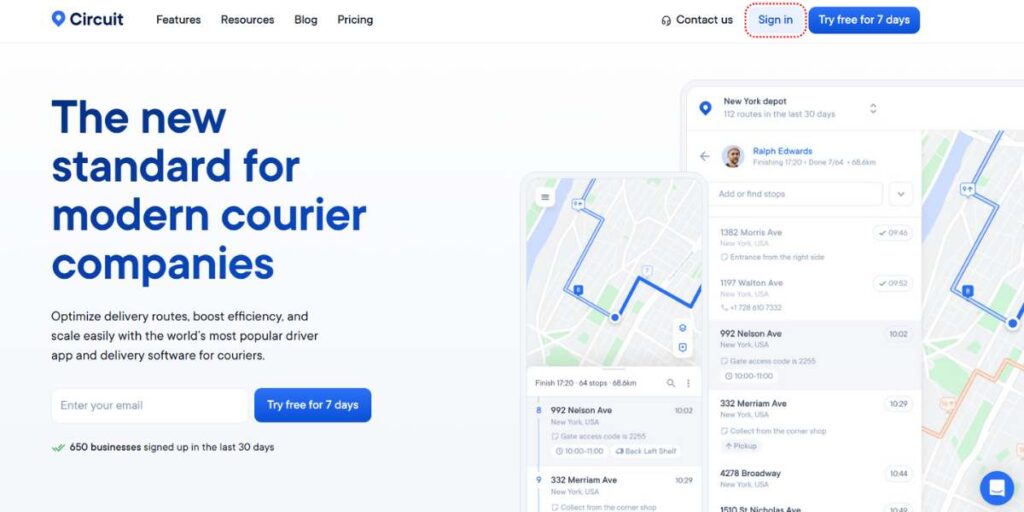
Circuit for Teams provides world-class features to small and medium-sized organizations at a friendly cost. The tool was developed based on the feedback of the already famous Circuit Route Planner mobile application, which made it a full-fledged team-based tool. The power of Circuit is in its impeccable combination of functionality and simplicity that provides powerful optimization algorithms without bombarding the user with excessive complexity.
The software is the best in terms of collaborative route planning whereby different team members can be involved in creation and management of routes. Circuit for Teams has been specifically made to include functions which are needed in a team setup, and by solving the communication and coordination problems usually associated with multi-driver operations.
Key Features:
- Team-based route planning and management
- Driver mobile app with optimized navigation
- Real-time route sharing and updates
- Stop prioritization and time window management
- Performance tracking and reporting
- Simple integration with existing business tools
Pros:
- Excellent balance of features and simplicity
- Very competitive pricing for team features
- Strong mobile app experience for drivers
Cons:
- Fewer advanced enterprise features
- Limited API and integration options
Best For: Small to medium teams seeking collaborative route optimization without complexity
Pricing: Plans start at $100/month for up to 10 drivers, with per-driver pricing for larger teams
6. WorkWave Route Manager
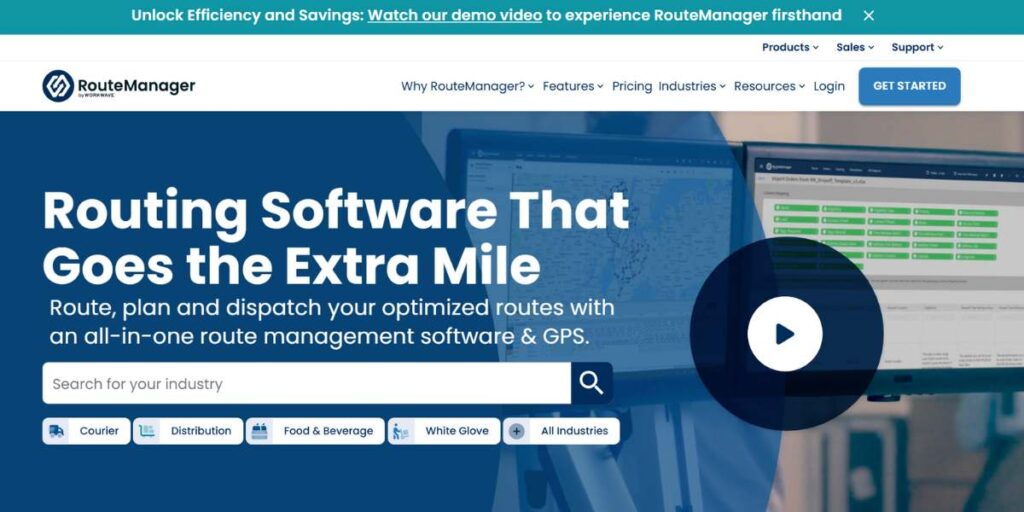
WorkWave Route Manager is a name in enterprise-level apps for lumberjoring high-level field service delivery and maintenance operations. The platform combines route optimization with a full set of workforce management features, creating a one-stop shop for complex service businesses. WorkWave’s algorithm, for instance, solves complex cases involving technician skills, equipment requirements, service time windows, and priority assignments.
The strength of the software lies in handling the service process from scheduling to actual service implementation and billing. Territory management, performance analytics, and customer portal integration being the advanced features, WorkWave Route Manager would be best suited to businesses requiring more comprehensive operational control.
Key Features:
- Advanced workforce and territory management
- Skills-based routing and technician assignment
- Customer portal with self-scheduling options
- Comprehensive business intelligence reporting
- Mobile workforce app with offline capabilities
- Integration with major business software platforms
Pros:
- Comprehensive enterprise feature set
- Strong integration capabilities with business systems
- Excellent support for complex field service scenarios
Cons:
- Higher cost structure suited for larger businesses
- Longer implementation time due to feature complexity
Best For: Large field service companies and enterprises requiring comprehensive workforce management
Pricing: Custom enterprise pricing starting around $45/month per user with implementation costs
7. Upper Route Planner
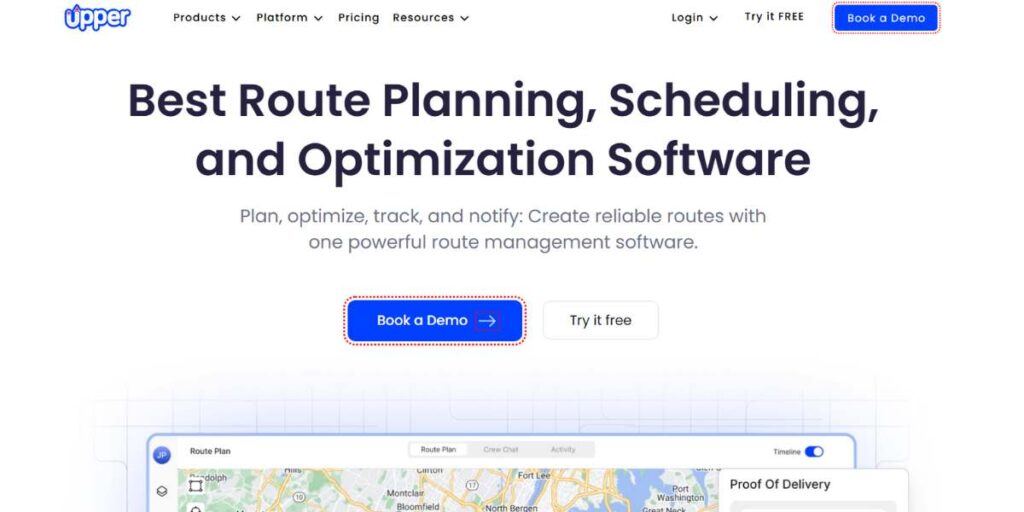
This particular Upper Route Planner is a platform that caters primarily to providing essential features that can be used with great ease at an affordable price. At the top of its list, the platform places the emphasis on core optimization functionality, retaining a clean and intuitive interface that cuts training time and user frustration. Upper’s algorithm bridges multi-stop routing problems and the user parenting experience at stark contrasts, keeping it simple and actively accessible.
Practical features in the software include driver mobile apps, basic tracking capabilities, and easy-to-use reporting tools adequate for most small-to-medium delivery operations. Building on this approach, it serves businesses seeking simple and reliable route optimization without investing into more advanced features they really don’t need.
Key Features:
- Quick route optimization for multiple vehicles
- Driver mobile app with navigation and updates
- Basic real-time tracking and notifications
- Simple reporting and analytics dashboard
- CSV import/export for easy data management
- Integration with popular mapping services
Pros:
- Very affordable pricing structure
- Simple learning curve and quick setup
- Reliable core optimization functionality
Cons:
- Limited advanced features and customization
- Fewer integration options than premium platforms
Best For: Small businesses and startups seeking affordable, reliable route optimization
Pricing: Plans start at $40/month for up to 3 drivers, with scalable pricing options
8. Locus Dispatcher

Locus Dispatcher introduces the latest technology to Route Optimization Software by applying artificial intelligence and machine learning algorithms into it. The platform is constantly being trained on the patterns of delivery, on traffic situations and the data about its operation in order to enhance optimization over time. Locus is also good at the dynamic routing situation when conditions vary often during the day and its routes are automatically adjusted to ensure optimal performance.
The AI methodology of the software goes far beyond the typical optimization of the routes, also providing predictive analytics, demand forecasting, and smart resource allocation. Locus Dispatcher is sure to attract technology-savvy companies that want to gain competitive advantages by using advanced optimization.
Key Features:
- AI-powered route optimization with machine learning
- Predictive analytics and demand forecasting
- Dynamic re-optimization based on real-time conditions
- Advanced vehicle and driver assignment algorithms
- Comprehensive dashboard with actionable insights
- Flexible API for custom integrations and workflows
Pros:
- Cutting-edge AI technology provides superior optimization
- Excellent scalability for growing businesses
- Strong analytics and predictive capabilities
Cons:
- Higher learning curve due to advanced features
- Premium pricing reflects advanced technology investment
Best For: Technology-forward businesses seeking AI-powered optimization and advanced analytics
Pricing: Custom pricing based on business size and requirements, typically starting at enterprise levels
9. Google Maps Route Planner (Advanced Use via My Maps or API)
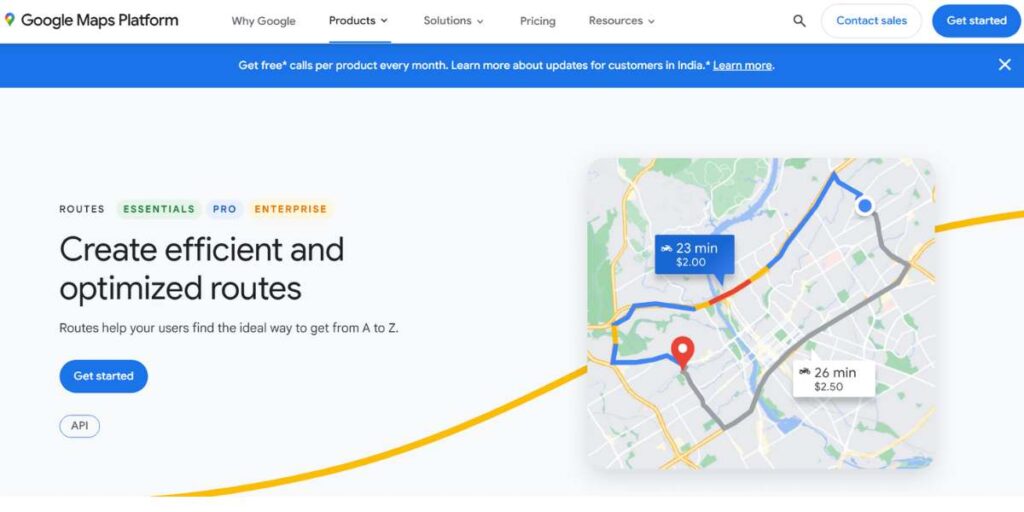
Google Maps has advanced features, such as My Maps to create simple multi-stop plans and Maps API to create custom route optimization solutions. Although it is not a specialized route optimization tool, real-time traffic data, and worldwide coverage make it an acceptable alternative to companies that have the technical capability. Google Maps Platform API enables developers to build special route optimization solutions customized to the requirements of a particular business, using the best mapping technology and data accuracy that Google can offer.
This is a good way of doing things in case the business has special needs that cannot be carried out off-the-shelf or in case the business wants to incorporate route optimization into its current applications.
Key Features:
- Access to Google’s comprehensive mapping data
- Real-time traffic and road condition information
- Global coverage with high accuracy
- Flexible API for custom development
- Integration with other Google services
- Scalable pricing based on usage
Pros:
- Leverages the world’s most comprehensive mapping data
- Highly customizable through API development
- Cost-effective for businesses with development resources
Cons:
- Requires technical expertise for advanced implementations
- Lacks built-in business features of dedicated platforms
Best For: Businesses with development resources seeking custom route optimization solutions
Pricing: My Maps is free; API pricing varies based on usage, starting at $5 per 1,000 requests
10. MyRouteOnline
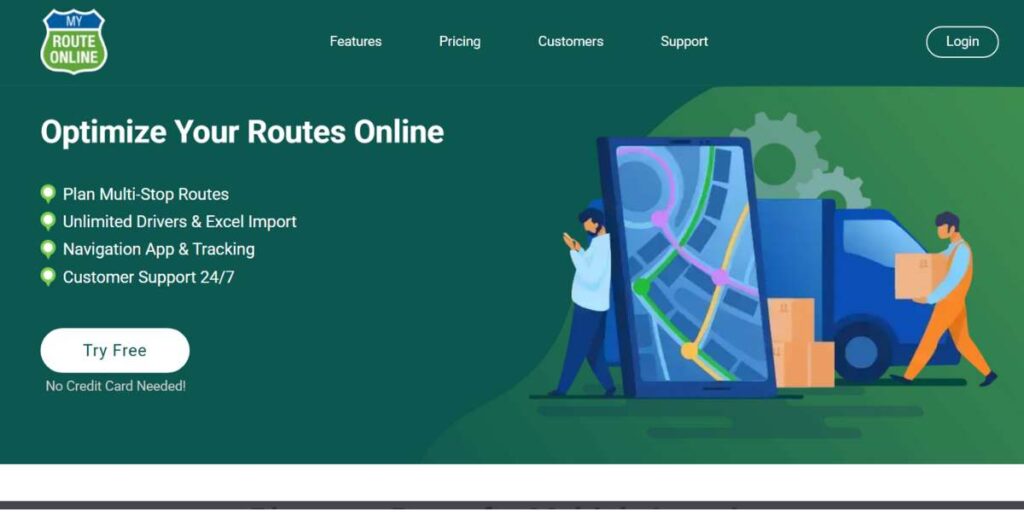
MyRouteOnline has simple designs to make them easy and readily usable. The platform is dedicated to optimum route optimization capabilities without the overly complicated business features and thus is ideal when users require fast and dependable route planning. The advantage of MyRouteOnline is that it can effectively perform simple multi-stop routing with a user interface that is very simple.
The software is suitable to businesses, and service providers that require an occasional route optimization but do not require the full-scale fleet management solutions overhead.
Key Features:
- Simple multi-stop route optimization
- Export routes to various GPS devices and apps
- Basic time and distance calculations
- Support for different vehicle types and restrictions
- Simple CSV import for batch address processing
- Straightforward web-based interface
Pros:
- Extremely simple and quick to use
- Very affordable pricing for basic features
- No learning curve or training required
Cons:
- Limited features compared to comprehensive platforms
- No real-time tracking or mobile driver apps
Best For: Individual users and small businesses needing basic route optimization
Pricing: Plans start at $8.25/month for basic features, with annual discounts available
How to Choose the Right Route Optimization Software
- Check Your Size and Complexity: A small firm with short, straightforward runs may get by with entry-level route software, but a larger outfit juggling tight windows, vehicle limits, and special cargo will want driver-matching tools and detailed reports.
- Think About Connections: Choose a system that plugs easily into your CRM, stock control, accounts, and web store so data moves automatically and your people don’t have to double-enter or chase missing figures.
- Plan for the Field: Key mobile features are offline maps, proof-of-delivery capture, live chat with dispatch, and a screen that stays clear in sunshine or rain on any smartphone or tablet your crew already carries.
- Balance Cost and Value: Don t just count the sticker price; add set-up, training, help desk calls, and any features you might turn on later, then compare that with time saved, fuel trim, and happier customers.
- Look to the Future: Ask how many stops, trucks, and drivers the plan can handle before it hits a ceiling, and whether extra modules such as AI planning or fleet telematics show up as your business grows.
- Test Support: Probe the vendors support hours, online guides, live training, on-site kick-off, and named account manager, because a great app is worthless if help comes slow or only after an expensive ticket.
Future Trends in Route Optimization
- Artificial Intelligence and Machine Learning Integration: Route Optimization Software increasingly incorporates AI algorithms that learn by scrutinizing historical data, patterns in traffic, and delivery success rate to continually better their ability in optimization.
- Autonomous Vehicle Preparation: Top-tier platforms are working on the development of features to support autonomous delivery vehicles, including special routing algorithms for unmanned vehicles and hybrid routing combining traditional and autonomous delivery methods for maximum output.
- Sustainability and Carbon Footprint Optimization: Awareness for the environment is bringing the development of green routing features to the forefront that aim at fuel efficiency, electric vehicle range optimization, and carbon footprint minimization.
- Real-time Adaptability Enhancement: The new generation of Route Optimization Software will bring about more intelligent real-time adjustments, including dynamic changes of customer preferences, keeping routes at their optimal level throughout the delivery day, regardless of changing circumstances.
- IoT Integration: Connected vehicle sensors, smart delivery boxes, and IoT-enabled inventory systems will feed Route Optimization Software with unprecedented data streams, package conditions, and infrastructure availability for more intelligent routing decisions.
Conclusion
Route Optimization Software that was once the luxury of large businesses has now become the necessity of the businesses of any size that want to achieve efficiency in their operations and gain competitive edge. The provided guide presents ten solutions that suggest various solutions to multi-stop routing problems, including the simplest and cost-effective solutions to small business to advanced AI-enabled platforms used by enterprises.
With the customer demand constantly growing and the costs of operation rapidly increasing, the issue is not whether to implement route optimization technology but rather how to find the right solution that suits your particular needs and future company growth. Quality Route Optimization Software investment generally pays itself back in months in term of savings at the gas pump and increased customer satisfaction, and is one of the most significant technology investments a modern day delivery company can make.
FAQs
How much will Route Optimization Software on average save me?
Fuel costs are typically reduced by 10-30% with 15-25% increase in delivery efficiency which usually pay themselves off in 3-6 months after being implemented in most businesses.
Does Route Optimization Software work with same-day delivery orders?
Indeed, dynamic routing is a feature available in modern platforms, which can add urgent orders and re-optimise planned routes in real-time without interfering with the planned deliveries.
What is the time to configure Route Optimization Software?
The implementation process takes different durations based on the level of integration and training of staff involved, and it can be as fast as immediate usage (in case of simple platforms) and up to 2-8 weeks (in case of enterprise solutions).
Is special training required to use route optimization tools by drivers?
The majority of the modern solutions have user-friendly mobile applications that do not need significant training, which can take 30-2 hours, depending on the level of platform complexity and the set of features.
What would occur in case Route Optimization Software becomes off-line?
Offline mobile Qualities High-quality platforms offer offline mobile functionality, which enables drivers to keep driving based on the optimized routes, and deliver in case of lacking internet connections.
